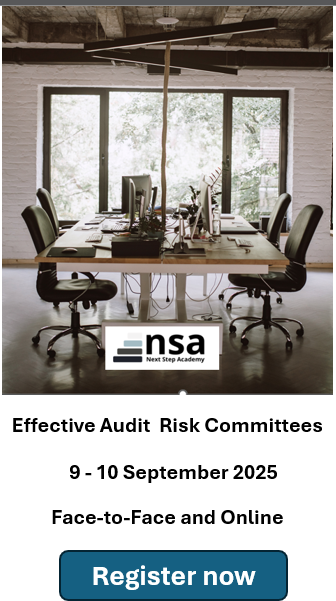Effective Audit and Risk Committees
This course is designed to ignite a passion for lifelong learning by strengthening problem-solving skills, encouraging logical and simplified thinking, and providing practical tools applicable across various organisational functions.
It also offers an in-depth exploration of risk oversight principles, with a strong focus on the role and effectiveness of the Risk Management Committee. Through a blend of expert-led sessions, case studies, and interactive exercises, participants will gain the knowledge and skills needed to enhance their organisation’s risk governance and oversight framework.
Course outcomes:
By the end of this course, participants will be able to:
- Understand the key components of effective risk oversight and governance
- Implement best practices for Risk Management Committee operations
- Develop a risk-aware culture within their organisation
- Align risk management strategies with organisational objectives
- Effectively communicate risk information to stakeholders
How you will benefit?
Based on the course description and search results, attendees can expect to gain the following benefits:
- Enhance your ability to provide effective risk oversight at the board level
- Learn to establish and operate a high-performing Risk Management Committee
- Develop strategies for fostering a risk-aware culture throughout your organisation
- Gain insights into aligning risk management with strategic objectives
- Network with peers and share best practices in risk governance
Day 1: Ethics Risk Assessments (ERA) – Deon van der Westhuizen
Session 1: Introduction
- The world that we live in: BANI vs. VUCA
- The Common Risk Language for this course
Session 2: Risk Oversight: What does it mean in Practice?
- Why is Risk Oversight important?
- Risk Governance as a conduit for Critical Thinking and INFORMED Decision-making
- Embedding a Risk Culture throughout the organization
- Develop the appropriate Risk Attitude for your organisation
- Barriers to Risk Implementation
Session 3: Risk Oversight in Action through an effective and efficient Risk Management Committee (RMC)
- Purpose of the RMC
- Authority, Size, Composition and Competencies of RMC members
- Chairperson’s Eligibility and terms of Appointment
- Reconstitution
- Duties and Responsibilities of Chairperson, RMC members, Risk Owners, Risk Champions, Company Secretary, Governance Roles and Responsibilities, e.g. Risk Management Plan, Risk Management Framework, Risk Management Policy, etc.
- Risk Management Roles and Responsibilities, e.g. Risk Reporting, Risk Mitigation, etc.
Day 2: Achieving Psychological Safety – Charissa Bloomberg
Session 4: Integrated Risk Management
- The optimum structure design to ensure effective ARC’s
- The alignment between Risk, Audit and Compliance
- Risk appetite and Tolerance
Session 5: Risk Reporting:
- Role of Collaboration and Communication
- Critical Thinking & Decision Making
- Performance versus Risk
- Alignment with Risk Appetite and Variation of Performance
- Narrative Intelligence
Session 6: Practical exercises
- Alignment with mission critical objectives
- Risk Dashboard Reporting
- Informed and reliable decision-making
Who should Attend?
- Risk Management Professionals
- Corporate Governance Officers
- Organisational Development & Transformation Specialists
- Line Managers, Team Leaders, and Supervisors
- Executives and Board Members
Subscription price – R2 880 per person.
Normal price – R3 880 per person.
Group discounts apply for 3+ people from the same organization.
This course only R1750 per person.
Subscription price – R1000 per person – Unlimited access to our online courses.
Format: – Zoom, Teams, Google meet
Subscription fee of R1 000 gives access to all online learning in a calendar year and access to our Shaping Future Leaders sessions (minimum of 60 hours of online training) and minimum 10 Shaping Future Leaders sessions.
All sessions are hosted by professional specialists with at least 30 years’ experience in the GRC, ESG and AI space.
Unlimited access to the Centre of Excellence.
Delegates should review the content and levels of the course they are registering for to ensure suitability and that they are registering for the correct course. Payment: Full payment must be received 7 working days prior to the course.
Cancellations must be submitted in writing to admin@nsa.edu.za no later than 7 working days before the start of the training.
- A cancellation fee of R700.00 will apply for any cancellations received after this period.
- If a cancellation is received 3 working days or less before the training, the full invoice amount will be payable.
- Proof of payment must be emailed to admin@nsa.edu.za.za before the training date.
- Substitutions may be made at no additional cost.
Delegates will be personally liable for the payment of the full registration fee in the event of non-attendance or failure to cancel in writing prior to the deadline of 7 working days. Unless the registration was completed after the stated timeframe, the delegate must make prior arrangements with NSA.
NSA reserves the right to postpone, reschedule, or cancel any service due to insufficient enrolments or unforeseen circumstances. In such cases, a full refund or option to reschedule will be offered. NSA endeavours to host the specified training on the date as advertised. However, if unforeseen circumstances arise or due to extenuating circumstances out of our control, NSA reserves the right to cancel the training. NSA does not store credit card details, nor do we share customer details with any 3rd parties. NSA reserves the right to make changes to the training program and to refuse any booking.
No delegate will be permitted to attend the training without the following:
- A signed and approved Purchase Order,
- Proof of payment, or
- A Commitment Letter on the company’s official letterhead, acknowledging the invoice and confirming the payment date. This letter must be signed by a Finance, Procurement, or authorised official responsible for final payment approvals.
All payments must be received before the training starts and no later than 7 working days prior to commencement. In the case of late registrations, special arrangements must be made with the relevant NSA representatives.
Dietary Requirements: (This only applicable to In-Person Attendance) – Dietary requirements received 3 days prior to the commencement of training can be accommodated.

